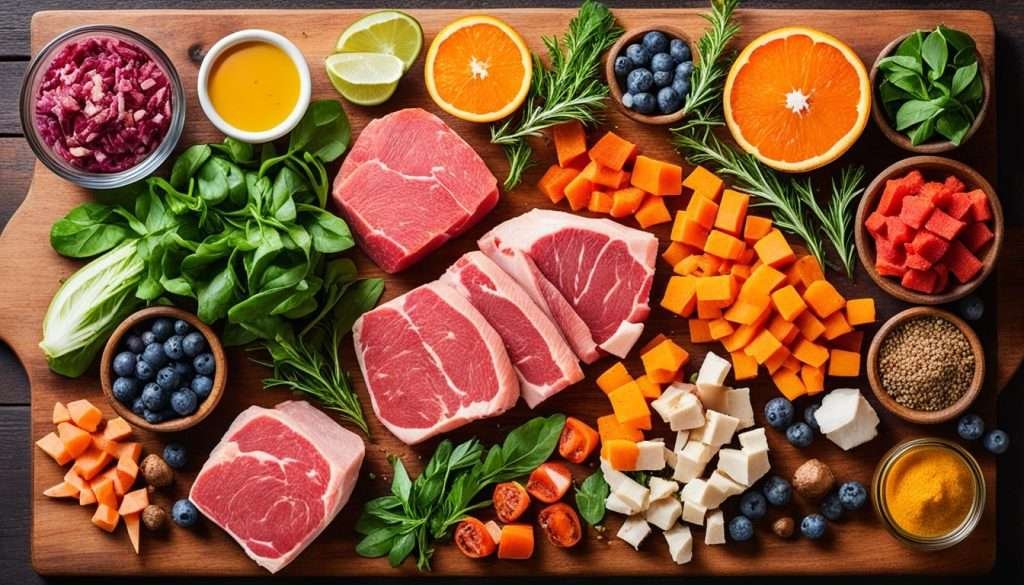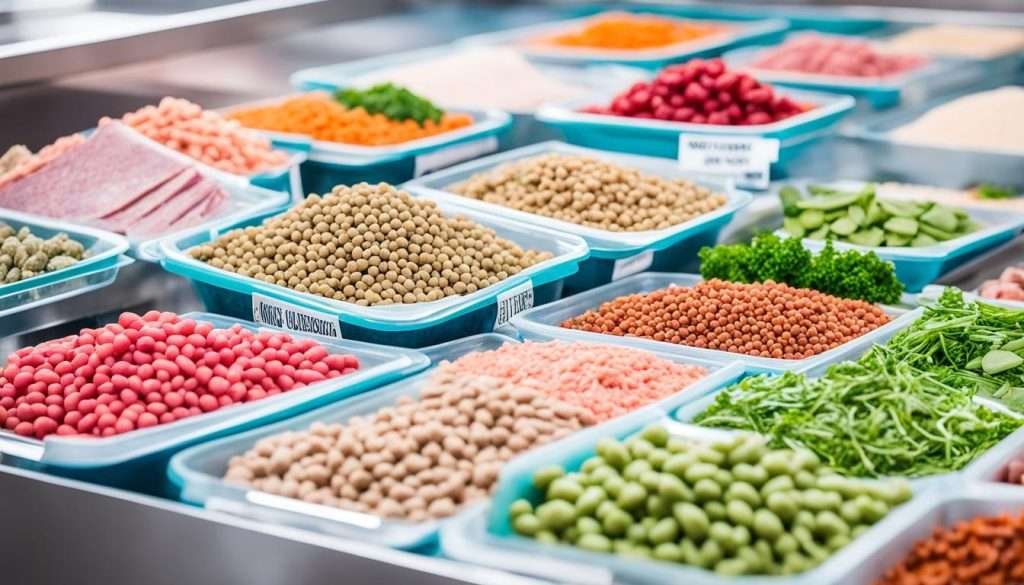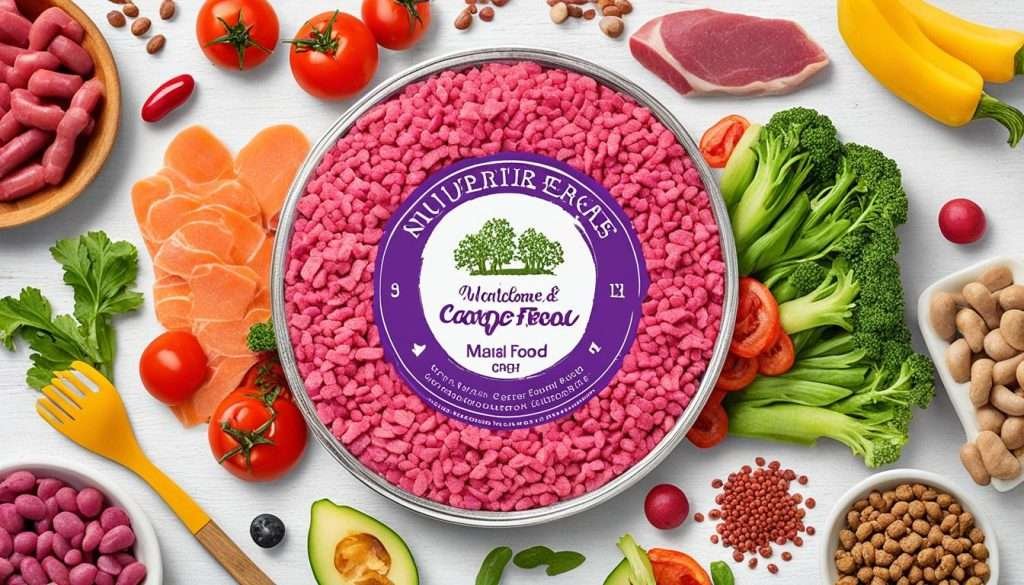What is the best raw cat food? with more and more cat owners are choosing raw diets for their pets. Raw cat food includes ingredients like muscle meat, organs, and bones. These are similar to what cats would eat in the wild. People think it helps with digestion, skin health, and dental care.
But, there are risks too. Raw food can have harmful bacteria. This article will look at the best raw cat food, its good and bad points, and how to switch your cat safely.

Key Takeaways
- Raw cat food is an increasingly popular diet option that mimics a cat’s natural whole-prey diet.
- Proponents claim raw food offers benefits like better digestion, healthier skin and coat, and improved dental health.
- Potential safety risks include the possibility of bacterial contamination, requiring careful handling and storage.
- Selecting the best raw cat food brands and properly transitioning your cat to a raw diet are important considerations.
- Raw cat food can be a nutritious option, but pet owners should weigh the pros and cons to ensure their cat’s safety and overall well-being.
Introduction to Raw Cat Food
Cats need a diet full of animal proteins to stay healthy. Raw cat food is like what they would eat in the wild. It gives them the nutrients they need in a good form. Raw cat food benefits include better digestion, healthier skin, less dental tartar, and a shiny coat.
Why Feed Cats a Raw Diet?
Cats are meant to eat raw meat, bones, and organs. Their bodies are made to break down and use these foods well. A raw diet helps them eat like their wild ancestors, giving them the nutrients they need.
Benefits of Raw Cat Food
- Improved digestion and nutrient absorption
- Healthier skin and coat with a lustrous shine
- Reduced dental tartar and fresher breath
- Stronger immune system and overall better health
- More energy and a leaner, more muscular physique
But, raw cat food risks like salmonella and listeria are there too. It’s key to handle and store raw cat food safely to keep your cat safe.
“Cats are obligate carnivores, meaning they require a diet rich in animal-based proteins to thrive.”
What is the Best Raw Cat Food?
When looking for the best raw cat food, focus on products that mimic a cat’s natural diet. This means a mix of muscle meat, organs, and bones. These ingredients give cats the nutrients they need to stay healthy.
Top Raw Cat Food Brands
Some top raw cat food brands include:
- Open Farm – They use high-quality, ethically raised ingredients. Their raw foods are safe and free from harmful stuff.
- Stella & Chewy’s – They offer nutrient-rich, freeze-dried raw foods. These are easy to use for a raw diet.
- Instinct – They have many raw, frozen, and freeze-dried options. All are made with natural, minimally processed ingredients.
- Primal Pet Foods – Their raw cat foods are made to match what cats would eat in the wild. No synthetic additives are used.
When picking the best raw cat food, look at ingredient quality, nutrient balance, and safety. Good brands focus on ethical sourcing, quality control, and nutrition. They make sure their food meets a cat’s special dietary needs.
“Cats are obligate carnivores that require high dietary protein levels as they use protein rather than carbohydrates as their primary energy source.”
Choosing a high-quality raw cat food from a trusted brand helps your cat get the best nutrition. It also lowers the risks of homemade or low-quality foods.
Raw Cat Food Ingredients
The best raw cat foods are made to match a cat’s natural whole-prey diet. This diet has about 84% muscle meat, 6% bone, 5% liver, and 5% other organ meats. This mix ensures cats get the right amount of protein, fat, and nutrients they need.
Top raw cat food brands use high-quality ingredients like chicken, turkey, or fish. They also add organ meats and ground bone for a complete diet. This makes the food similar to what cats eat in the wild.
Whole-Prey Inspired Nutrition
The best raw cat food recipes aim to give cats the nutrition they’d get from whole prey animals. This includes:
- Muscle meat, which is the main source of protein and essential amino acids
- Organ meats, such as liver, which are full of vitamins and minerals
- Bone, which gives calcium and other minerals for strong bones and teeth
| Ingredient | Percentage |
|---|---|
| Muscle Meat | 84% |
| Bone | 6% |
| Liver | 5% |
| Other Organ Meats | 5% |
This mix of raw cat food ingredients makes sure cats get the nutrients they need for a whole-prey diet for cats.

“The best raw cat food brands use high-quality, animal-based ingredients like chicken, turkey, or fish as the primary protein source, along with organ meats and ground bone to deliver a complete and balanced diet.”
Safety Concerns with Raw Cat Food
A raw cat food diet has many benefits but also some safety risks. Bacteria like Salmonella and Listeria can be in raw meat. These can be harmful to cats and their owners. It’s important to handle and store raw cat food safely to keep your cat safe.
Handling and Storage Tips
To lower the risks of raw cat food, follow these important tips:
- Wash your hands well with soap and water after touching raw cat food.
- Clean all surfaces and tools that touch the raw food with disinfectant.
- Keep raw cat food in the freezer or fridge to stop bacteria from growing.
- Don’t mix raw cat food with other food to avoid contamination.
- Talk to your vet for advice on how to store and handle the food.
The CDC, FDA, and WSAVA say there’s a big risk of bacteria spreading from raw cat food. A recent study showed that about 25% of raw cat food samples had harmful bacteria. This includes Salmonella and Listeria monocytogenes.
Healthy adult cats can fight off some bacteria, but others are more at risk. These include very young, very old, or sick cats. It’s important to be careful with food safety to stop serious infections in cats and people.

Deciding on a raw cat food diet should be talked over with your vet. They can give advice based on your cat’s health and needs. By handling and storing food safely, you can lower the risks and keep your cat healthy.
Nutritional Completeness in Raw Diets
It’s key to make sure a raw cat food diet is complete and balanced for your cat’s health. Raw diets have many benefits but often don’t meet AAFCO nutrient standards. This can mean your cat might not get the right mix of proteins, fats, vitamins, and minerals.
So, it’s important to pick a brand that offers a balanced diet for your cat. Getting help from a board-certified veterinary nutritionist can also be a big help. They can make a raw diet for your cat that fits its needs.
Importance of Proper Formulation
Raw diets that aren’t made right can cause serious health issues in cats. For instance, not having enough taurine can hurt your cat’s eyes and heart. An imbalance of calcium and phosphorus can affect their bones and metabolism.
Make sure any raw cat food you choose, whether store-bought or homemade, follows AAFCO standards. This ensures your cat gets all the nutrients it needs to stay healthy.
Potential Risks of Unbalanced Raw Diets
Feeding your cat an unbalanced raw cat food diet can cause many health problems, including:
- Nutrient deficiencies, such as lack of taurine, which can affect eye and heart health
- Mineral imbalances, like an excess of calcium or phosphorus, that can impact bone and metabolic function
- Digestive problems, such as diarrhea or vomiting, due to the introduction of new food sources
- Potential contamination with harmful bacteria, like Salmonella or E. coli, which can cause severe illness
To avoid these risks, always work with your vet or a pet nutritionist when switching to a raw diet or making your own raw food.
| Nutrient | Importance for Cats | Risks of Deficiency |
|---|---|---|
| Taurine | Essential for eye and heart health | Vision problems, heart disease |
| Calcium and Phosphorus | Vital for bone and metabolic function | Skeletal abnormalities, muscle weakness |
| Vitamins and Minerals | Support overall health and well-being | Various health issues, such as anemia, poor coat condition, and weakened immune system |
By making sure your cat’s raw cat food nutrition is complete and balanced, you can help them do well on a raw diet. This way, they can enjoy all the benefits it offers.

Commercial vs Homemade Raw Cat Food
Cat owners can choose between commercial raw cat food or making their own. Each option has its own benefits and things to consider.
Benefits of Commercial Raw Food
Commercial raw cat food is easy and saves time for pet owners. These foods are made to be complete and balanced for cats. They offer a variety of proteins like chicken, turkey, and beef, helping to keep meals interesting.
Also, commercial raw foods must meet strict safety and nutrition standards. This means they are safe from harmful bacteria and have the right nutrients. Cat owners can feel confident about their pet’s diet.
Homemade Raw Diet Considerations
Homemade raw diets let you control what goes into your cat’s food. It’s great for cats with special health needs or tastes. But, it’s important to work with a vet to make sure the diet is right.
Homemade diets take more time and effort to prepare and store. They can also cost more, depending on the ingredients and how much you make.

Choosing between commercial and homemade raw cat food depends on your cat’s needs and your time. Think about what’s best for your cat and talk to your vet. This way, you can make a choice that keeps your cat healthy and happy.
Transitioning to a Raw Diet
It’s important to slowly switch your cat to a raw diet to prevent stomach upset. Begin by adding a little raw food to their usual diet. Gradually increase the raw food over 1-2 weeks. Watch for how your cat reacts, looking for signs they like it or if they have any bad reactions.
Cats can be picky when trying new foods. They get used to foods early in life. Young kittens and cats that hunt are usually easier to switch to raw food. But, cats over 6 months old might find it harder to switch from kibble to raw.
If your cat eats kibble, mix raw food with it and increase the raw food bit by bit. If they eat wet food, put raw food next to it to help them get used to it. Adding moisture or broth to kibble can also help them get used to raw food.
- Start by replacing just 10% of your cat’s current diet with raw food.
- Cats that have been on the same diet for a long time might not see raw meat as food.
- Recommended protein sequence for transitioning: Mystic Chicken, Chicken with Salmon Vibes, Magic Rabbit, Wonder Turkey.
During the switch, make sure your cat has fresh water and watch their energy, weight, and health. Being patient is key to successfully switching your cat to a raw diet. You might see changes in their stool when they switch to raw food.
Switching a cat to a raw diet should take about two weeks for their digestive system to adjust. A raw diet can help with chronic issues like bladder problems, diabetes, and digestive issues. It can also improve their coat, teeth, and energy levels.
Cost of Feeding Raw Cat Food
Feeding your cat a raw diet can be costly. Raw cat food costs between $2 to $5 per day. This depends on the brand, ingredients, and how much you give your cat. Even though it might cost more than dry or canned food, many owners think it’s worth it for their cat’s health.
The market for fresh/frozen/refrigerated pet food for cats has grown a lot. Sales have jumped by 648.5% to about $1 million. This shows how popular raw and minimally processed diets are becoming for cats.
Feeding a raw cat food daily can cost between $0.61 to $3.90. Making your own raw food can be cheaper, costing $0.20 to $1.00 a day. In comparison, premium kibble costs $0.16 to $1.03 daily, and canned food can be $0.87 to $5.48 a day.
| Food Type | Daily Cost Range (10 lb Cat) |
|---|---|
| Commercial Raw Frozen | $0.68 – $1.31 |
| Homemade Raw | $0.20 – $1.00 |
| Premium/Super-Premium Kibble | $0.16 – $1.03 |
| Canned Food | $0.87 – $5.48 |
At first, raw cat food might seem expensive. But, many owners see benefits like better health, more energy, and fewer health issues. These benefits can make the cost worth it. Deciding on a raw diet should consider your cat’s needs, your budget, and your vet’s advice.
“Solving dietary problems through raw diets is seen as a cheaper alternative to repeated veterinary visits and expensive medications.”
Raw Cat Food Recipes
For cat owners looking to make a homemade raw diet, there are easy recipes that offer a balanced nutrition. These recipes use whole-prey ingredients. This ensures your cat gets the nutrients they need to stay healthy.
Easy Homemade Raw Food Recipes
A simple recipe includes chicken with ground bone, organ meats, and supplements. It makes food for 2.5 to 3 weeks. Cats should eat a third to half a cup, twice a day. The ingredients are:
- 5.5-6 lbs of chicken thighs
- 7 oz of chicken livers
- 14 oz of chicken hearts
- Taurine, vitamin E, lysine powder, and Wild Salmon Oil supplements
There’s also a turkey-based recipe with ground bone, organ meats, and supplements. Both recipes are made by vets to meet AAFCO standards.
When making raw food at home, work with a board-certified nutritionist. They help ensure the recipe fits your cat’s needs. They guide on portions, nutrient balance, and supplements.
To prepare, mix the ingredients in a big bowl. Then, put the food in Tupperware containers. Before serving, slightly warm the portions. Avoid microwaving and thaw under hot water instead.
Homemade raw cat food takes time, research, and money. But, it’s worth it for the health benefits and the chance to customize your cat’s diet.
Conclusion
Switching your cat to a raw diet can be a great choice. It gives them food that’s closer to what they would eat in the wild. But, make sure to research the best raw cat food options carefully. Also, talk to your vet to make sure your cat gets all the nutrients they need.
Choosing a high-quality raw product or making a balanced homemade diet with a pro can boost your cat’s health. This way, you’re supporting their overall health and happiness.
Raw cat food has many benefits, but there are also risks to consider. These include the chance of bacterial contamination and the need for balanced nutrients. By staying informed and talking with your vet, you can make the best choice for your cat.
Deciding to switch to a raw diet is a personal choice. You should think about what’s best for your cat’s needs and your lifestyle. With the right approach, a raw cat food diet can be a great way to feed your cat and keep them healthy.


